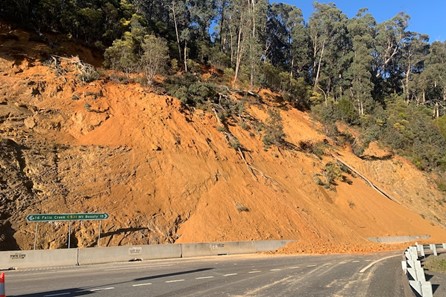The stability of slopes is impacted by multiple factors, the type of materials in (and under) the slope, environmental factors local to the slope, and of course gravity. This blog takes a brief slide down the factors affecting slope stability – let’s go!
Slope stability is ultimately determined by factors such as the angle of the slope and the strength of the materials on it, time can also play a role in the structural integrity. Mass wasting happens because tectonic processes have created uplift. Erosion, driven by gravity, is the inevitable response to that uplift, and various types of erosion, including mass wasting, have created slopes in the uplifted regions.
Slopes are created by uplift followed by erosion. In areas with relatively recent uplift, slopes tend to be quite steep. This is especially true where glaciation has taken place because glaciers in mountainous terrain create steep-sided valleys. In areas without recent uplift, slopes are less steep because hundreds of millions of years of erosion (including mass wasting) have made them that way. However, as we’ll see, some mass wasting can happen even on relatively gentle slopes.
The strength of the materials on slopes can vary widely. Solid rocks tend to be strong, but there is a very wide range of rock strength. If we consider just the strength of the rocks, and ignore issues like fracturing and layering, then most crystalline rocks — like granite,
basalt, or gneiss — are very strong, while some metamorphic rocks — like schist — are moderately strong. Sedimentary rocks have variable strength. Dolostone and some limestones are strong, most sandstone and conglomerate are moderately strong, and some sandstone and all mudstones are quite weak. Fractures, metamorphic foliation, or bedding can significantly reduce the strength of a body of rock, and in the context of mass wasting, this is most critical if the planes of weakness are parallel to the slope and least critical if they are perpendicular to the slope.
How Water Affects Land & Slopes Stability
Apart from the type of material on a slope, the amount of water that the material contains is the most important factor controlling its strength. Granular sediments have lots of spaces between the grains. Those spaces may be completely dry (filled only with air); or moist (often meaning that some spaces are water filled, some grains have a film of water around them, and small amounts of water are present where grains are touching each other); or completely saturated. Unconsolidated sediments tend to be strongest when they are moist because the small amounts of water at the grain boundaries hold the grains together with surface tension. Dry sediments are held together only by the friction between grains, and if they are well sorted or well rounded, or both, that cohesion is weak. Saturated sediments tend to be the weakest of all because the large amount of water pushes the grains apart, reducing the mount friction between grains. This is especially true if the water is under pressure.Effects of Water On Rock
Water will also reduce the strength of solid rock, especially if it has fractures, bedding planes, or clay-bearing zones. This effect is even more significant when the water is under pressure, which is why you’ll often see holes drilled into rocks on road cuts to relieve this pressure.Effects of Water on Clay
Water also has a particular effect on clay-bearing materials. All clay minerals will absorb a little bit of water, and this reduces their strength. The smectite clays (such as the bentonite) can absorb a lot of water, and that water pushes the sheets apart at a molecular level and makes the mineral swell. Smectite that has expanded in this way has almost no strength; it is extremely slippery. And finally, water can significantly increase the mass of the material on a slope, which increases the gravitational force pushing it down. A body of sediment that has 25% porosity and is saturated with water weighs approximately 13% more than it does when it is completely dry, so the gravitational shear force is also 13% higher. One other process that can weaken a body of rock or sediment is shaking. The most obvious source of shaking is an earthquake, but shaking from highway traffic, construction, or mining will also do the job.Understanding the Factors that Influence Slope Stability is Crucial for Several Reasons
- Safety and Risk Management: Unstable slopes can lead to landslides, which pose significant risks to human life, property, and infrastructure. By understanding these factors, engineers and geologists can better predict and mitigate potential hazards, ensuring the safety of communities living near slopes.
- Infrastructure Protection: Roads, railways, bridges, and buildings located on or near slopes can be severely damaged by slope instability. Understanding slope stability helps in designing and constructing more resilient infrastructure that can withstand slope movements.
- Environmental Preservation: Slope failures can lead to environmental degradation, such as soil erosion, loss of vegetation, and water pollution. By studying slope stability, we can implement measures to protect and preserve the natural environment.
- Economic Impact: Slope failures can result in costly repairs and maintenance. Understanding and addressing the factors affecting slope stability can reduce the economic burden associated with these events by preventing damage and reducing the need for frequent repairs.
- Land Use Planning: Effective land use planning requires knowledge of slope stability to avoid building in high-risk areas. This ensures sustainable development by selecting safer locations for construction and other activities.
- Resource Management: In industries such as mining and forestry, understanding slope stability is essential for managing resources safely and efficiently. It helps in planning operations that minimize the risk of slope failures and their associated impacts.
We are excited to announce our participation in some of the most influential industry events and conferences this year. Join us to discover the latest innovations and how Kurloo Technology is leading the way in precision monitoring and geospatial solutions.
